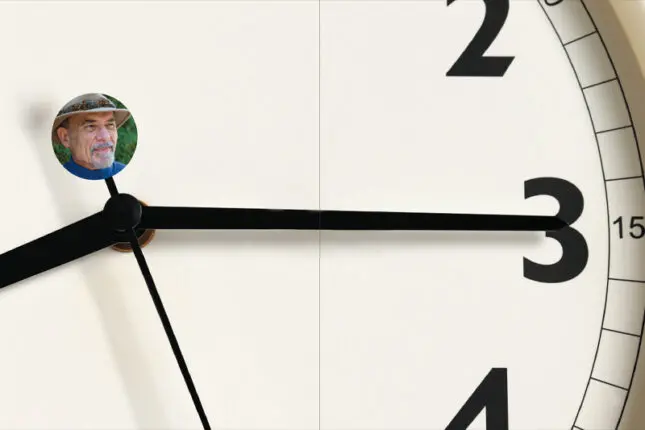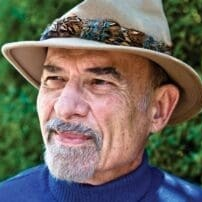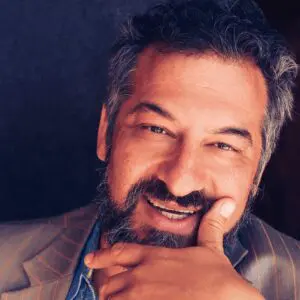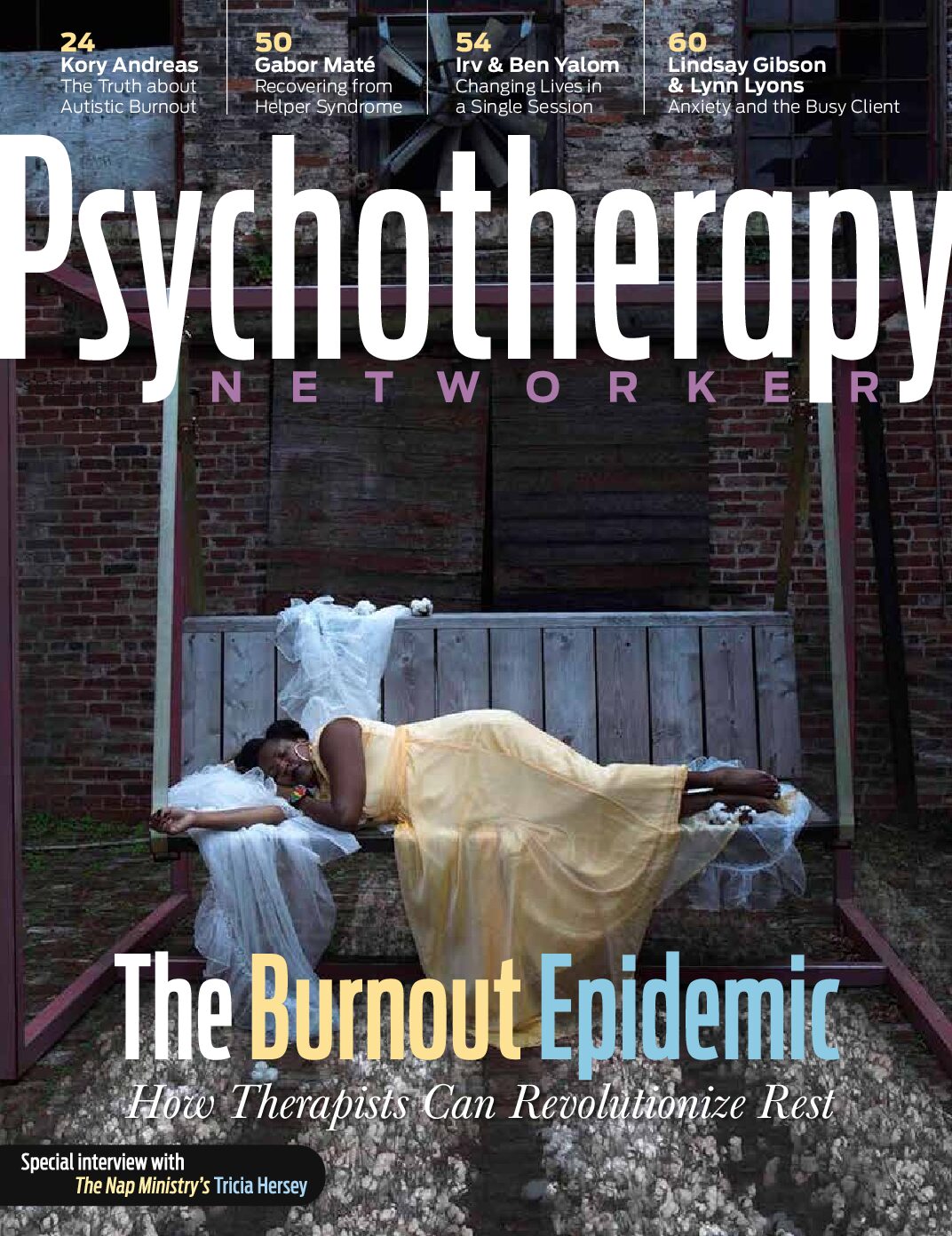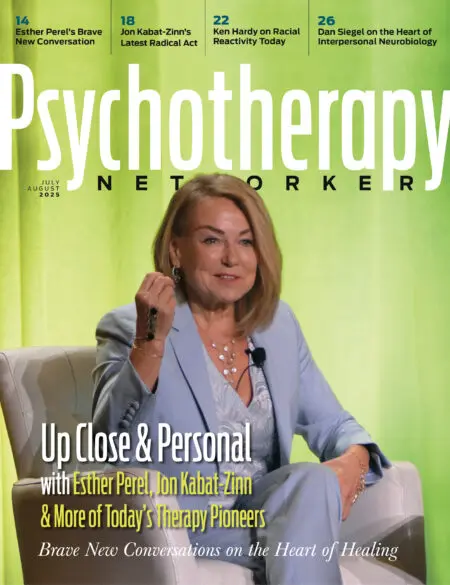Enjoy the audio version of this article—perfect for listening on the go.
Several years ago, when he reached his late 80s, my father, Irvin Yalom, felt that he could no longer continue to see therapy clients long-term, as he’d been doing faithfully for almost 60 years. His memory was starting to “flake away,” as he describes it, and he could no longer reliably recall critical details about his clients’ lives, nor many of the precious moments that had passed between him and them in sessions.
He contemplated hanging it all up, turning in his therapist’s badge and sailing off into some imagined sunset, but my father has never been one to rest on his laurels. He’d undoubtedly be restless, and the sense of purpose that had come from helping others—the central activity of his entire adult life—would gnaw at him ravenously. So he hit upon an unusual solution: he’d see clients for one-time consultations, single hours in which he’d attempt to offer both empathy and guidance—not to work miracles, but simply to help these fellow travelers a bit along their journeys.
This arrangement appealed for several reasons. First, after six decades of groundbreaking work as a clinician, he had unparalleled experience, and felt certain he could still be of assistance to those seeking help. Second, he was eager to see what useful lessons could be gleaned from this experiment, which he would report back to the field in the form of stories, an activity he’s been engaged in ever since writing The Theory and Practice of Group Psychotherapy in 1970. Finally, it was, he freely admitted, a way of warding off his own feelings of uselessness.
Over the next three years, he met with almost 300 clients for single sessions. This period coincided with the covid pandemic, so meetings were held over Zoom—still novel at the time—with folks from all around the world. And from these meetings, he selected some 40 to write as stories, ones he believed might offer some insight into the workings of good therapy—or even into the vicissitudes, joys, and inevitable indignities of human existence. This collection forms the backbone of Hour of the Heart, the book from which this piece is excerpted.
The story you’re about to read is written in my father’s voice. Many therapists have read his books before, and some tell me they hear his encouraging voice in their mind when they’re sitting with clients. But the book is also a collaboration between my father and me. By the time he stopped offering these one-time sessions, his memory had declined to the point where he could no longer hold all of these stories and the lessons within them. The sheer volume had become overwhelming.
Fortunately, we’d collaborated on his writing in the past. And as luck would have it, after many years as a theater director, I’d recently changed careers and joined the “family business” by enrolling in a PhD program in Marriage and Family Therapy, which meant I was able to work with him from a place of experience. Together, we wove a selection of these stories into a book that provides not just valuable lessons about therapy, but reflections on aging and memory loss.
The clients my father saw for these single sessions often had some knowledge of him beforehand, as well as great reverence for him given his standing in the field. But it’s important to note that all therapists, famous or not, are powerful figures in their clients’ lives. We should never underestimate that our caring presence is perhaps the most essential therapy tool when it comes to fostering change and growth.
My father’s approach to therapy focuses largely on the here and now, meaning that the real-time interactions between the therapist and client often reveal clues about why the client is struggling, and the relationship that develops between the two can become the locus of insight and of change. “It’s the relationship that heals,” my father often says. This approach relies less on the past than the present, and it’s thanks to this therapy approach that this late-life experiment was even possible. As you’ll see from the following story, the here and now is a great place to begin.
Maya’s face startled me. She was disarmingly beautiful, with dark reddish hair and green-gold eyes. Her smile was radiant, with a glow that seemed to reach out across the decades, bringing me back to my own youth for a moment. Ah, to have the feeling of immortality once again! She exuded a peaceful serenity from my computer screen, and I found myself somewhat off-balance, which was surprising. I am rarely so thrown by appearances and noted my response, wondering if her beauty startled others as well, and perhaps altered how they responded to her. I have worked with multiple patients for whom a beautiful face proved to be both a blessing and a curse, eliciting unwanted attention or special treatment, adulation from some and resentment from others. Both extremes skew normal interactions, and I suspected this would be relevant to our session.
I was still formulating a first question when she launched right into her reasons for contacting me. Obviously, I was not the first therapist she had seen.
“I’m 28. I’ve been with Charlie since I was 21, and I expect to marry him. But he is getting fed up with my preoccupation with Gilbert.”
“Who is Gilbert?” I inquired. “And how long has he been in your life?”
“About three months.”
“And he is?”
“I got him soon after he was born.”
Curious! Was her evasion intentional?
Maya seemed delighted, and watched my confusion for a moment with an almost playful expression.
“Gilbert is my dog,” she finally explained. “He’s the light of my life. And that’s my problem right there.” Maya sat back in her chair. She appeared relaxed, with no trace of concern. Perfectly at ease.
“Fill me in. What’s the problem?”
“It’s obsessional thinking. And sometimes behavior. It’s been my issue as long as I can remember. For years I obsessed about food, couldn’t stop thinking about it. So I measured every gram of carbohydrates, every gram of fat that passed through my lips. I weighed myself constantly. That’s pretty much all I remember from college, really. No great books. No wacky antics with friends. Just How much did I eat? and Am I still beautiful?”
“And what about now?”
“Now my obsessional thoughts are different—although that took a lot of work and a number of therapists, and a few not entirely inaccurate diagnoses of OCD and eating disorders. But now I obsess about Gilbert. Here.” She showed me a picture on her phone of her holding a small gray-and-white dog wearing a blue collar. “He’s just so cute! I can’t get him out of my mind. I worry about him all the time. Is he eating enough? Is he lonely all day when I’m gone? I go to class, and all I think about is poor lonely Gilbert. I know he needs to have another dog for company.”
“And Charlie’s attitude toward your dog?”
“I’d have to say, not good. Not good at all. Charlie works hard and has very long hours—he does commercial real estate. When he comes home, he’s beat. I know he needs downtime, I know he needs my attention. But I absolutely can’t not talk about Gilbert. I just can’t. Is Gilbert happy? What do you think, Charlie? He doesn’t look happy. He’s alone too much, by himself for hours at a time. He needs a friend. Shouldn’t we get another dog to keep him company? I know I should be thinking about my classes and about Charlie and about our future but, instead, it’s always Gilbert. It’s just so hard to think of anything else.”
Her words were telling me that she was concerned, that she could not escape invasive thoughts, that there was danger there. It made sense. But her demeanor was serene, a simple beatific smile playing across her face. The dissonance was striking, and I felt sure it would prove important in the hour to come.
“My mind just goes on and on. Poor lonely puppy waiting for me,” she continued. “Of course he needs company. Every living creature needs company. And Gilbert is just so small and new to the world. And so loving, and every day he must think I’ve abandoned him.”
I had asked her about Charlie, and she had deftly steered the conversation right back to Gilbert, our conversation bearing out the pattern of her obsessive thoughts.
“And Charlie?” I redirected.
“Most of the time when Charlie gets home, I can’t wait until he takes his coat off before I start talking about Gilbert. About how lonely he must be, and—”
“Maya, let me interrupt you. Let’s really focus on Charlie for a moment. How does he respond to all of these Gilbert thoughts?”
“Charlie is a kind, sweet man. He listens, and he truly cares for me. He doesn’t say it, but I believe he’s running out of patience. I know I talk too much about Gilbert and about my fantasy.”
“Your fantasy?”
Now her face truly lit up, glowing with youth and joy. “My fantasy, my dream for the long term, is to move to this gorgeous forest area, just a couple of hours away from here.”
“Tell me more,” I said. “What do you imagine your life will be like there?”
“Well, I’ll have nine or ten dogs. Gilbert would love it! He’ll be jumping up and down with happiness and it will all be perfect.”
“Perfect?”
“I mean I know we’ll live happily ever after. Me and Gilbert and all the other dogs!”
I took this in for a moment. Her youthful smile suddenly seemed more naive, less glorious. Something seemed off. I grew up in the inner city and have never felt entirely comfortable out in the wilderness. Perhaps the strong negative response I was feeling was this bias? I examined my own thinking for a moment. Certainly one could live a wonderful life out in the countryside, even if it didn’t appeal to me. That wasn’t it. It was the “happily ever after” that struck me as so strangely detached. My mind went to how she’d teased me at the beginning of our session, letting me imagine Gilbert was another man rather than a dog. Perhaps this was more of that playfulness? Maybe she was just joking.
“It will be beautiful,” she continued earnestly. “Tall trees, dappled shade, puppies leaping and scampering about. So happy.”
She appeared to be entirely serious. I started to feel concerned.
“And Charlie?” I asked. “Does he share this fantasy? How would he find work in real estate in the middle of the wilderness?”
“Reality, reality, I know! But Charlie can come with me. It’s not so far away, just a couple of hours.”
“So four or five hours of commuting daily?”
“Or he could spend part of the year here, working, and spend the rest of the year with me.”
That serene smile never wavered. If Charlie was already struggling with her obsession with Gilbert, it was clear there was no real place for him in this new vision. How could she not see that?
“And do you think Charlie will be happy with this arrangement?”
“He loves me. And he’ll see how happy I am, how happy Gilbert is.”
“And that will be enough for him? Enough companionship, driving hours to see you every once in a while? You did say that you love him and plan to marry him?”
“Oh yes. I know it will work out.”
The more I pushed, the more committed to her vision she became. She believed her words. And she appeared truly excited about this fairy-tale future. Perhaps it was my lack of imagination, but I simply couldn’t see how this could work without her relationship imploding, and who knows what else in her life falling by the wayside.
I pressed harder. “Maya, could you describe the typical day you imagine out in the woods?”
“I’ll be happy with the dogs all day. I love training dogs. We’ll take long walks, run around in the woods. Gilbert will be delirious. Sheer heaven.”
“What will you do for work?”
“Train more dogs! And maybe some remote web design. Easy-peasy.”
“And your evenings? Every evening alone, at least when Charlie’s not there?”
“Well, that would be a bit of a problem. I’d probably use a lot of alcohol. When I’m alone I do tend to drink.” She paused for a moment, with an almost pensive look on her face. For a moment I thought she would suddenly see the dissonance between the happily-ever-after fantasy and the real-life demands of her relationship, of her drinking, of having a satisfying life beyond the dogs.
Instead she turned back to me with a glowing grin.
I looked carefully at her face and again saw no worries, no concerns—only that unwavering smile. I felt as if we were living in two different realities, seeing the same set of circumstances in completely different ways. The scenario she described spelled probable disaster to me and perfect delight to her. Many of us seek out serenity, a calm disposition, and contentment in our lives. But I’ve learned that, paradoxically, too much serenity on the surface often indicates a denial of deeper problems. It can be a potent avoidance strategy. I wondered how far down Maya’s self-deception went. At some deep level I felt she must be aware of the looming danger.
“Okay,” I said, thinking I would play out a thought experiment with her, so she might see the probable results of her fantasy. “Let’s look at this together. Let’s imagine this all goes the way you’ve described it. Every day, Charlie needs to commute many hours to work so that you can live in the forest with your dogs? Does that sound right?”
“I’m sure it will all work out.”
“You really don’t see a problem?”
She shook her head and continued smiling that glassy grin. What planet was she from? I thought. How should I proceed? I noticed that I was unusually hesitant to confront her and trouble her supremely calm demeanor. This suggested to me that others who knew her, her friends and loved ones, might also find it hard to be honest with her about her relationship. Apparently no one had done so yet, and I realized it was now my unpleasant responsibility.
“I want you to hear something,” I said. I pulled up the original email she had sent me and read aloud:
I constantly seek reassurance that I am beautiful and young as though it gives me some sort of immortality or importance. . . . I worry sometimes that I’ll look back on my whole life wondering why and how I let myself waste it. This is why I’d love to work with you, Dr. Yalom—I believe you can help me find a way to not let my obsessions consume my future.
“I’m struck by your words in this email, Maya. You’re making some important observations and I take your thoughts very seriously.”
She nodded and continued smiling.
“I want you to pay careful attention to what I’m about to say. I think you are in great danger at this moment. You’ve been with Charlie for many years now. You say you love him and that you expect to spend your life with him. But from where I am sitting, that seems extremely unlikely unless something radical changes. You tell me that each night when Charlie comes home, exhausted from work, the only thing you can talk about is Gilbert—how lonely Gilbert must be, what Gilbert needs, how guilty you feel about not doing enough for Gilbert. I’m going to be very direct with you. This relationship is not going to last. The idea of living in the forest with ten dogs and Charlie is, I suspect part of you realizes, deeply improbable. You tell me that Charlie cannot work in the wilderness and that he is not interested in dogs. Forcing him to commute four or five hours sends the clear message that you value him less than you value your pet. I can’t see anyone remaining in that relationship, and I doubt Charlie, however much he may love you, is the exception. So where would that leave you? Alone in the wilderness with 10 dogs and a bottle every night. Is that truly the life you want for yourself?”
Maya’s smile finally faded.
I waited a few moments. She did not respond. “Here,” I continued, “let me read these lines again”:
I worry sometimes that I’ll look back on my whole life wondering why and how I let myself waste it. This is why I’d love to work with you. . . . I believe you can help me find a way to not let my obsessions consume my future.
We sat silently together for several moments and then Maya, her face solemn now, spoke. “I’m a bit stunned by what you’ve just said to me, Dr. Yalom. Thank you. I’ve been waiting for those words. I needed to hear them. I consider your comments to be tough love.”
“Yes, I think that is right,” I said. “Think of it as a wake-up call.”
“What do I do?”
“You’ll have to find your way through the emotions and give your real priorities precedence over the obsessional thoughts.”
“How?”
“It will take more than one hour, but fortunately this is something a good therapist should be able to help you through. I’ll do some investigating and send you contact information for a couple of excellent psychologists in your area.”
I ended the session with mixed feelings. I’m rarely so confrontational, I thought. Had I been too harsh? Was she ready to hear this? One thing I was learning is that the effort to be truly helpful in these single-hour sessions often involved enormous time pressure, pressure that necessitated I make choices I would not otherwise, choices that don’t follow the same logic as my accustomed therapy. In Maya’s case, I resorted to a very direct confrontation, whereas generally it is far more effective to lead patients toward making these discoveries for themselves. As therapists we lay out possibilities and ask thought-provoking questions that often cause patients to consider how they are living, whether their actions align with their values, and whether their beliefs are serving them well, understanding all along that deep change has to come from within.
There is a difficult irony here because patients usually come to therapy in significant distress. What they want in that state, by and large, is a solution to the suffering they are experiencing, whether the problem appears to be external or internal. And this solution, they often imagine, is advice about what to do. But again, real change needs to come from the patient reconsidering their own tendencies and making a shift rather than being told what to do in a given situation. Almost always there is a lot less utility in my telling someone what to do rather than helping them overcome whatever internal obstacles they have so they can reach their own conclusions that better align with their deeper values.
But I was learning that there was little time for this in-depth process in most single sessions, particularly with someone as committed to her delusions as Maya was. In retrospect, I had attempted to let her see for herself how incongruous her fantasy life was with having a happy relationship with Charlie. I assumed the dissonance would shake her from her serenity, but it hadn’t happened. Instead she’d responded, “I’m sure it will all work out!” So I’d given her a more direct shock by reading her own words to her and expressing my strong feeling that Charlie would not remain with her, a second-class citizen to her dogs. My uncharacteristically blunt words shook away her placid smile. Hopefully it would inspire her to get further sustained help. A follow-up email from Maya bore this out:
Dr. Yalom,
Please know that I did not feel unsettled at all by your words. On the contrary, I did not want our session to end. I don’t have many people in my life who are truly honest with me. It felt liberating to hear you say out loud what I’ve feared but what no one will say.
You instilled a sense of urgency: I need to figure out how to be in my relationship sooner rather than later. I trust your expertise enough to know that if you fear for my future, then I should too.
A few weeks later I mailed her this story and requested her permission to publish it. She responded:
Reading this, I felt jolted again by the realization that I have been jeopardizing my relationship with Charlie. I even told him what you had said, and he did not deny the severity of the situation.
I laughed out loud at your wondering what planet I am from. I can’t usually see how absurd my thinking is, but this made it clear. With the help of the therapist you suggested, I have decided to re-home Gilbert. I am devastated and I cry many times each day. Now I obsess over what it means that I can love a being so much and give him up. Still, I am thankful that our session enabled me to distance myself from my short-term fixation on Gilbert and focus on the importance of my long-term relationship with Charlie.
Part of me wants to scream that you’ve sucked the joy out of life. Why shouldn’t I have a fairy tale? A happily ever-after, with puppies frolicking as the birds chirp in the meadow? But you’re entirely right about Charlie, and probably many other close relationships. I love the idea of the puppies being so happy, but I do not want to live life alone, with wine as my primary non-canine companion. Still, on my sad days I shall think of you as “fun’s executioner.”
With gratitude,
Maya
Irvin Yalom
Irvin D. Yalom, MD, is one of the world’s foremost psychiatrists, a visionary therapist and internationally bestselling author who has helped define the fields of group psychotherapy and existential therapy. His textbooks Theory and Practice of Group Psychotherapy and Existential Therapy remain standards for therapists in training worldwide, as does The Gift of Therapy: An Open Letter to a New Generation of Therapists and Their Patients. He’s also the author of the New York Times best-sellers Love’s Executioner, Momma and the Meaning of Life, Creatures of a Day, and Staring at the Sun: Overcoming the Terror of Death. A consummate storyteller, his teaching novels based in philosophical inquiry and psychological insight, including When Nietzsche Wept, The Schopenhauer Cure, Lying on the Couch, and The Spinoza Problem, have been best sellers in multiple countries. More at www.yalom.com
Benjamin Yalom
Benjamin Yalom, PhD, AMFT, is a psychotherapist, theater-maker, and writer. He practices narrative and existential therapy, focusing on aligning one’s values with one’s way of living and unlocking creative approaches to work and life. Prior to his work in marriage and family therapy, he was the visionary force behind foolsFURY, an influential experimental theater group which helped transform San Francisco’s performing arts scene between 1998-2020. More at www.yalomtherapy.com

